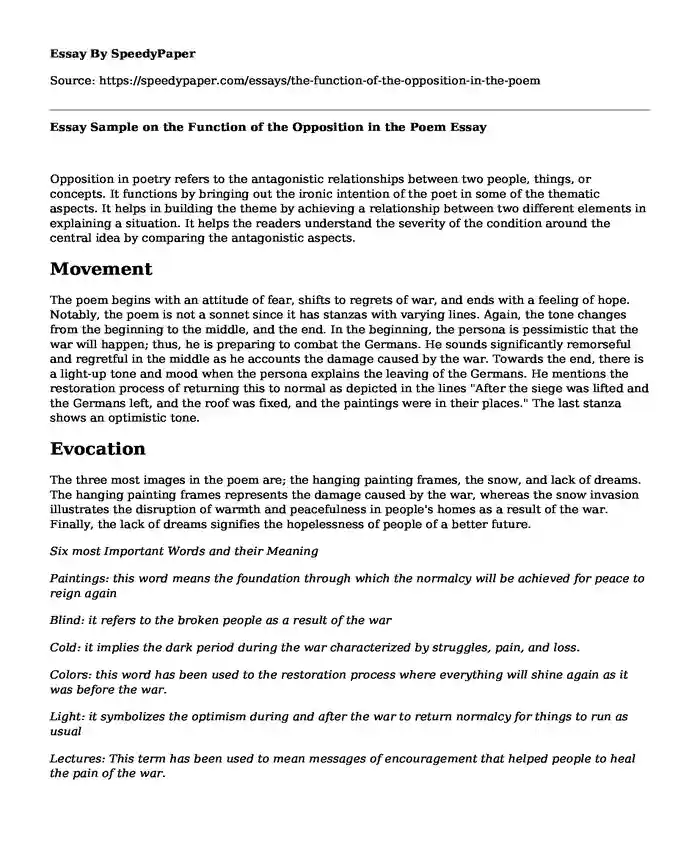
| Type of paper: | Course work |
| Categories: | Poem Analysis War Emotional intelligence |
| Pages: | 3 |
| Wordcount: | 812 words |
Opposition in poetry refers to the antagonistic relationships between two people, things, or concepts. It functions by bringing out the ironic intention of the poet in some of the thematic aspects. It helps in building the theme by achieving a relationship between two different elements in explaining a situation. It helps the readers understand the severity of the condition around the central idea by comparing the antagonistic aspects.
Movement
The poem begins with an attitude of fear, shifts to regrets of war, and ends with a feeling of hope. Notably, the poem is not a sonnet since it has stanzas with varying lines. Again, the tone changes from the beginning to the middle, and the end. In the beginning, the persona is pessimistic that the war will happen; thus, he is preparing to combat the Germans. He sounds significantly remorseful and regretful in the middle as he accounts the damage caused by the war. Towards the end, there is a light-up tone and mood when the persona explains the leaving of the Germans. He mentions the restoration process of returning this to normal as depicted in the lines "After the siege was lifted and the Germans left, and the roof was fixed, and the paintings were in their places." The last stanza shows an optimistic tone.
Evocation
The three most images in the poem are; the hanging painting frames, the snow, and lack of dreams. The hanging painting frames represents the damage caused by the war, whereas the snow invasion illustrates the disruption of warmth and peacefulness in people's homes as a result of the war. Finally, the lack of dreams signifies the hopelessness of people of a better future.
Six most Important Words and their Meaning
Paintings: this word means the foundation through which the normalcy will be achieved for peace to reign again
Blind: it refers to the broken people as a result of the war
Cold: it implies the dark period during the war characterized by struggles, pain, and loss.
Colors: this word has been used to the restoration process where everything will shine again as it was before the war.
Light: it symbolizes the optimism during and after the war to return normalcy for things to run as usual
Lectures: This term has been used to mean messages of encouragement that helped people to heal the pain of the war.
Music
The poem's rhyme is irregular has it has unmatched sounds at the end of the lines. Notably, it partly has a rhythm which is achieved by the repetition of words that, in turn, causes a flow of sound.
Notation
The readers can transcribe the poem's musical structure by analyzing the lines and the stanzas to determine whether they constitute rhyme and rhythm. For instance, the poem's rhyme is irregular since the endings of the lines do not have matching syllables sounds. Another aspect of analyzing the musical structure of the poem is through the lines' length and the meter. Length in poetry refers to the number of feet in the meter. In The Curator, the meter is iambic as most of its lines contain unaccented syllables that produce a flowing beat. Also, the lines vary in size to achieve an intonation of the syllables
Another aspect that contributes to a poem musical structure is enjambment. It refers to an incomplete idea in a line which is continued in the next one. A line with an enjambment does not have punctuation marks. This feature is reflected in the poem. For instance, in the second stanza, the first line is an enjambment as its meaning completes in the one that follows. This technique is useful in achieving and maintaining a tonal range of the poem to represent an idea.
Tensions
The Curator relays a message of hope amidst situations of despair. The central theme of the piece is war and its effects. The author narrates the events that took place during wartime after the German invasion. He highlights the pains, the struggles, and the loss that people had to endure during the war, together with the effects in the aftermath. More so, he demonstrates the range of feelings, from fear to hopelessness that is involved during such times. Also, he recounts the journey that was used to retain normalcy during the reconstruction and the healing process. Importantly, this poem is anti-war, as the poet demonstrates how wars can be destructive to people, as well as their surroundings. It shows how optimism instead of pessimism, can be used as a tool of regaining positivity during stressful situations. Again, the poet shows how people forget or rather ignore the issues that lead them into trouble. For instance, in the last stanza, the poet explains how blind people stop visiting the painting after everything is returned to normalcy. The message in this part shows how people do not learn from their troubles.
Cite this page
Essay Sample on the Function of the Opposition in the Poem. (2023, Feb 09). Retrieved from https://speedypaper.net/essays/the-function-of-the-opposition-in-the-poem
Request Removal
If you are the original author of this essay and no longer wish to have it published on the SpeedyPaper website, please click below to request its removal:
- Dental Hygiene Essay Examples
- Free Essay in Philosophy: Aristotle, Plato, and Nietzsche
- Free Essay on Civil-Military Relations
- Business Plan Essay Example
- Marketing Essay Example on the Apple Watch
- Essay Example: SleepyWhispers
- French Pride: The Tough, Yet Worthwhile Journey of a "True French Debutant" - Free Paper
Popular categories




